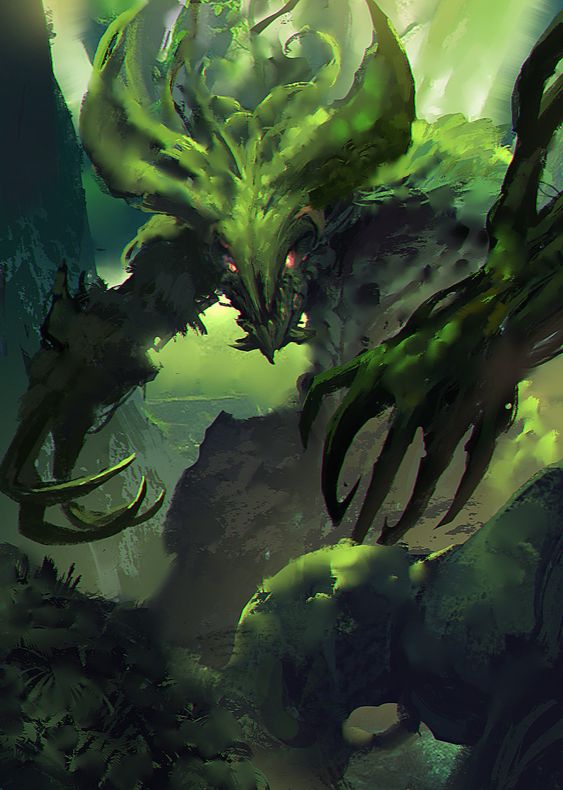


Treant
Treants are awakened trees that dwell in ancient forests. Although treants prefer to while away the days, months, and years in quiet contemplation, they fiercely protect their woodland demesnes from outside threats.
The Sleeping Tree Awakens
A tree destined to become a treant meditates through a long cycle of seasons, living normally for decades or centuries before realizing its potential. Trees that awaken do so only under special circumstances and in places steeped with nature’s magic. Treants and powerful druids can sense when a tree has the spark of potential, and they protect such trees in secret groves as they draw near the moment of their awakening. During the long process of awakening, a tree acquires face-like features in its bark, a division of the lower trunk into legs, and long branches bending downward to serve as its arms. When it is ready, the tree pulls its legs free from the clutching earth and joins its fellows in protecting its woodland home.
Legendary Guardians
After a treant awakens, it continues to grow exactly as it did when it was a tree. Treants created from the mightiest trees can reach great sizes while developing an innate magical power over plants and animals. Such treants can animate plants, using them to ensnare and trap intruders. They can call wild creatures to aid them or carry messages across great distances.
Protectors of the Wild
Even after awakening, a treant spends much of its time living as a tree. While rooted in place, a treant remains aware of its surroundings, and can perceive the effects of events taking place miles away based on subtle changes nearby.
Woodcutters who avoid culling healthy living trees and hunters who take only what they need of the forest’s bounty are unlikely to arouse a treant’s ire. Creatures careless with fire, those who poison the forest, and those who destroy great trees, especially a tree close to awakening, face the treant’s wrath.
Treant Individuality
There's something about the big, gentle presence of a treant that is both calming and energetically invigorating at the same time. Treants can represent the innocence of nature, even though treants have no standard age limit and can live for millenia, always growing, watching, and helping. Treants are all a little different. You can select or roll for a quirk from the table below.
| d6 | Quirk |
|---|---|
| 1 | Photovore. You view any kind of eating other than photosynthesis as strange, and maybe abhorrent. |
| 2 | Rain Lover. You absolutely adore the rain - it fills you with joy. Who doesn't love a water bath while walking? |
| 3 | Pet Keeper. You constantly have birds, squirrels, and other animals nesting or chirping on you. |
| 4 | Pyrophobic. Fire is a deathly worrisome danger, and thoughts of it fill your anxious mind. |
| 5 | Deliberate. You see no reason to do things quickly. You might have a motto such as "Don't be hasty." |
| 6 | Gender? As a tree, you have absolutely no concept of gender or sex. |
Treant Names
Treants usually take neames for themselves based on their appearance. For example, a treant with a ring of flowers around their head might take the name Thistlecrown. Not all treants pick names in this way, some treants use adjectives and nouns they find important, and other just use something that sounds suitably treelike.
Treant names are almost never linked to gender.
Treant Names. Benedict Lumberbatch, Birch Reynolds, Chris Pine, Greybough, Groot, Gordon Treeman, Johann Sebastian Bark, Melissa Joan Heartwood, Milton Burl, Trent, Treebeard, Thistlecrown, Willow
Treant Traits
All treants have certain traits in common with one another.
- Ability Score Increase. Your Constitution score increases by 2, and your Strength score increases by 1.
- Age. Treants can live anywhere from less than 100 years to more than a few thousand years depending on the species.
- Alignment. Most treants tend towards neutrality. Neutral good treants will help lost travelers, while neutral evil treants will seek to entrap and kill interlopers in their forests.
- Size. Younger treants tend to be a medium size of 7 to 8 feet tall, but treants can to grow in larger sizes. Your size is Medium.
- Speed. Your base walking speed is 30 feet.
- Plant. Your creature type is both Humanoid and Plant. Like most plants, you have a weakness to fire. You have disadvantage on saving throws against spells and effects that deal fire damage.
Your body is capable of producing its own food using the energy from the sun. As long as you are exposed to sunlight for at least 6 hours per day, you don't need to eat. You can still choose to eat food normally, though most Treants prefer to gain nourishment through light.
Additionally, if you are missing any limbs, new ones will take their place. This process usually takes about a year, but the exact time is up to your DM.
- Powerful Build. You count as one size larger when determining your carrying capacity and the weight you can push, drag, or lift.
- Nature’s Armor. Due to your barked skin and the shape of your body, you are ill-suited to wearing armor. Your bark provides ample protection, however; it gives you a base AC of 13 + your Constitution modifier. You gain no benefit from wearing armor, but if you are using a shield, you can apply the shield's bonus as normal.
- Take Root. If you are standing on dirt, grass, or other similar terrain, you can root yourself to the ground as an action. Until you use a bonus action to remove your roots from the earth, you gain a +4 bonus to AC, and you have advantage on Strength and Constitution saving throws. While rooted, your speed is 0 and can’t increase, you have disadvantage on Dexterity saving throws, you can’t take reactions, and the only action you can take is a bonus action to un-root yourself. While you are rooted, you are indistinguishable from a normal tree.
You don't need to sleep, and magic can't put you to sleep. When you take a long rest, you must root yourself into the ground, and stay that way for at least six hours.
- Languages. You can speak, read, and write Common and Sylvan.
Through speech and touch you can communicate simple ideas with living plants. You are able to interpret their responses in simple langauge. Most plants do not experience the world in the world in terms of sight, but they can feel differences in temperature, describe things that have touched them, as well as hear vibrations that have happened around them (including speech).





Awakened Blight
Awakened plants gifted with the powers of intelligence and mobility, blights plague lands contaminated by darkness. Drinking that darkness from the soil, a blight carries out the will of ancient evil and attempts to spread that evil wherever it can.
Roots of the Gulthias Tree
Legends tell of a vampire named Gulthias who worked terrible magic and raised up an abominable tower called Nightfang Spire. Gulthias was undone when a hero plunged a wooden stake through his heart, but as the vampire was destroyed, his blood infused the stake with a dreadful power. In time, tendrils of new growth sprouted from the wood, growing into a sapling infused with the vampire’s evil essence. It is said that a mad druid discovered the sapling, transplanting it to an underground grotto where it could grow. From this Gulthias tree came the seeds from which the first blights were sown.
Dark Conquest
Wherever a tree or plant is contaminated by a fragment of an evil mind or power, a Gulthias tree can rise to infest and corrupt the surrounding forest. Its evil spreads through root and soil to other plants, which perish or transform into blights. As those blights spread, they poison and uproot healthy plants, replacing them with brambles, toxic weeds, and others of their kind. In time, an infestation of blights can turn any land or forest into a place of corruption.
In forests infested with blights, trees and plants grow with supernatural speed. Vines and undergrowth rapidly spread through buildings and overrun trails and roads. After blights have killed or driven off their inhabitants, whole villages can disappear in the space of days.
Controlled by Evil
Blights are independent creatures, but most act under a Gulthias tree’s control, often displaying the habits and traits of the life force or spirit that spawned them. By attacking their progenitor’s old foes or seeking out treasures valuable to it, they carry on the legacy of long-lost evil.
Awakened
As an awakened blight, you have been separated from your evil brethren and are no longer under the influence of the Gulthia tree.
Awakened Blight Traits
Most awakened blights have certain traits in common with one another.
- Ability Score Increase. Your Constitution score increases by 2.
- Age. Blights are Seedlings until the age of 15 and Sproutlings until the age of 35, at which point they are considered adults. They have no known age limit.
- Alignment. Awakened blights are almost always Neutral Good, trying to separate themselves from their evil counterparts.
- Size. Your size depends on your subrace. Twig blights are Small, while Needle and Vine blights are Medium.
- Speed. Your base walking speed depends on your subrace. Vine blights and twig blights have a walking speed of 25 feet, while needle blights have a speed of 30.
- Blindsight. Possessing no real eyes, Awakened Blights have adapted to see without them. You gain Blindsight with a radius of 30 feet, and you are immune to the blinded condition. However, you are blind beyond this radius.
- Plant. Your creature type is both Humanoid and Plant. Like most plants, you have a weakness to fire. You have disadvantage on saving throws against spells and effects that deal fire damage.
Your body is capable of producing its own food using the energy from the sun. As long as you are exposed to sunlight for at least 6 hours per day, you don't need to eat. You can still choose to eat food normally, though most awakened blights prefer to gain nourishment through light.
Additionally, if you are missing any limbs, you regain them when you take a short or long rest.
- Natural Armor. When you aren’t wearing armor, your AC is 13 + your Dexterity modifier. You can use your natural armor to determine your AC if the armor you wear would leave you with a lower AC. A shield’s benefits apply as normal while you use your natural armor.
- Sleepless. You don't need to sleep, and magic can't put you to sleep. To gain the benefits of a long rest, you can spend at least six hours doing light activity such as reading and keeping watch.
- Languages. You can speak, read, and write Common and one other language of your choice.
- Subrace. There are three types of blights: Twig blights, needle blights, and vine blights. Choose one of these for your character.
Vine Blight
- Ability Score increase. Your Strength score increases by 1.
- Constricting Vines. You know the thorn whip cantrip.
When you reach 3rd level, you can cast the entangle spell once with this trait, and you regain the ability to do so when you finish a long rest. When you reach 5th level, you can cast the web spell once with this trait, and you regain the ability to do so when you finish a long rest. When you cast web in this way, it takes the form of a mass of vines.
Constitution is your spellcasting ability for these spells.
- False Appearance.. While you remain motionless, you are indistinguishable from a tangle of vines.
Needle Blight
- Ability Score increase. Either your Strength or Dexterity score increases by 1.
- Thorns. Your body is a natural weapon, which you can use to make unarmed strikes. If you hit with it, you deal piercing damage equal to 1d6 + your Strength modifier, instead of the bludgeoning damage normal for an unarmed strike.
Additionally, you can cast the hail of thorns spell, which can be triggered by your unarmed strikes, instead of a ranged weapon. Constitution is your spellcasting ability for it. Once you cast it in this way, you cannot do so again until you have finished a long rest.
Twig Blight
- Ability Score increase. Your Dexterity score increases by 1.
- Claws. Your sharp claws are natural weapons, which you can use to make unarmed strikes. If you hit with them, you deal slashing damage equal to 1d4 + your Dexterity modifier, instead of the bludgeoning damage normal for an unarmed strike.
- False Appearance.. While you remain motionless, you are indistinguishable from a dead shrub. Additionally, you are proficient in the Stealth skill.

Redwood Knight
The Redwood knights are a druidic order of treants who use ancient runes carved into their own bark to channel the magic of the ancient trees in order to grow to immense size.
Bonus Proficiencies
3rd-level Redwood Knight feature
You gain proficiency with woodcarver’s tools, and you learn to speak, read, and write Druidic.
Rune Carver
3rd-level Redwood Knight feature
You can use magic runes to enhance your gear. You learn two runes of your choice, from among the runes described below, and each time you gain a level in this class, you can replace one rune you know with a different one from this feature. When you reach certain levels in this class, you learn additional runes, as shown in the Runes Known table.
Runes Known
| Fighter Level | Number of Runes |
|---|---|
| 3rd | 2 |
| 7th | 3 |
| 10th | 4 |
| 15th | 5 |
Whenever you finish a long rest, you can inscribe a number of runes equal to the number of runes you know into your bark. Your rune remains until you finish a long rest.
The following runes are available to you when you learn a rune. If a rune has a level requirement, you must be at least that level in this class to learn the rune. If a rune requires a saving throw, your Rune Magic save DC equals 8 + your proficiency bonus + your Constitution modifier.
Faceless Rune. The motives of the great trees are ineffable. While inscribed with this rune, you have advantage on Dexterity (Sleight of Hand) checks and Charisma (Deception) checks.
In addition, when you or a creature you can see within 30 feet of you is hit by an attack roll, you can use your reaction to invoke the rune and choose a different creature within 30 feet of you, other than the attacker. The chosen creature becomes the target of the attack, using the same roll. This magic can transfer the attack’s effects regardless of the attack’s range. Once you invoke this rune, you can’t do so again until you finish a short or long rest.
Wildfire Rune. You have learned that fire can be used for your own ends. While inscribed with this rune, your proficiency bonus is doubled for any ability check you make that uses your proficiency with a tool.
In addition, when you hit a creature with an attack using a weapon, you can invoke the rune to summon fiery shackles: the target takes an extra 2d6 fire damage, and it must succeed on a Strength saving throw or be restrained for 1 minute. While restrained by the shackles, the target takes 2d6 fire damage at the start of each of its turns. The target can repeat the saving throw at the end of each of its turns, banishing the shackles on a success. Once you invoke this rune, you can’t do so again until you finish a short or long rest.
Imposing Rune. You can invoke the power of the colossal elder treants to increase the power of your mighty stature. While inscribed with this rune, you have advantage on Wisdom (Animal Handling) checks and Charisma (Intimidation) checks.
In addition, you can invoke the rune as a bonus action to increase your sturdiness. For 10 minutes, you gain a +2 bonus to all ability checks and saving throws that use Strength or Constitution. Once you invoke this rune, you can’t do so again until you finish a short or long rest.
Judgement Rune. This rune’s magic channels the judiciousness of the elder treants. While wearing or carrying an object inscribed with this rune, you have advantage on Wisdom (Insight) checks, and you have darkvision out to a range of 120 feet.
In addition, when a creature you can see ends its turn within 30 feet of you, you can use your reaction to invoke the rune and force the creature to make a Wisdom saving throw. Unless the save succeeds, the creature is charmed by you for 1 minute. While charmed in this way, the creature has a speed of 0 and is incapacitated, descending into a dreamy stupor. The creature repeats the saving throw at the end of each of its turns, ending the effect on a success. Once you invoke this rune, you can’t do so again until you finish a short or long rest.
Bark Rune (7th Level or Higher). This rune’s magic bestows upon you greater resilience. While bearing this rune, you have advantage on saving throws against being poisoned, and you have resistance against poison damage.
In addition, you can invoke the rune as a bonus action, gaining resistance to bludgeoning, piercing, and slashing damage for 1 minute. Once you invoke this rune, you can’t do so again until you finish a short or long rest.
Seer Rune (7th Level or Higher). The ancient trees have seen much in their long lives. While inscribed with this rune, you have advantage on Intelligence (Arcana) checks, and you can’t be surprised as long as you aren’t incapacitated.
In addition, you can invoke the rune as a bonus action to enter a prophetic state for 1 minute or until you’re incapacitated. Until the state ends, when you or another creature you can see within 60 feet of you makes an attack roll, a saving throw, or an ability check, you can use your reaction to cause the roll to have advantage or disadvantage. Once you invoke this rune, you can’t do so again until you finish a short or long rest.
Redwood’s Might
3rd-level Redwood Knight feature
You have learned how to imbue yourself with the might of the tallest redwood trees. As a bonus action, you magically gain the following benefits, which last for 1 minute:
If you are smaller than Large, you become Large, along with anything you are wearing. If you lack the room to become Large, your size doesn’t change. You have advantage on Strength checks and Strength saving throws. Once on each of your turns, one of your attacks with a weapon or an unarmed strike can deal an extra 1d6 damage to a target on a hit. You can use this feature a number of times equal to your proficiency bonus, and you regain all expended uses of it when you finish a long rest.
Runic Shield
7th-level Redwood Knight feature
You learn to invoke your rune magic to protect your allies. When another creature you can see within 60 feet of you is hit by an attack roll, you can use your reaction to force the attacker to reroll the d20 and use the new roll.
You can use this feature a number of times equal to your proficiency bonus, and you regain all expended uses when you finish a long rest.
Great Stature
10th-level Redwood Knight feature
The magic of your runes permanently alters you. When you gain this feature, roll 3d4. You grow a number of inches in height equal to the roll.
Moreover, the extra damage you deal with your Giant’s Might feature increases to 1d8.
Master of Runes
15th-level Rune Knight feature
You can invoke each rune you know from your Rune Carver feature twice, rather than once, and you regain all expended uses when you finish a short or long rest.
Runic Juggernaut
18th-level Rune Knight feature
You learn how to amplify your accelerated growth. As a result, the extra damage you deal with the Redwood’s Might feature increases to 1d10. Moreover, when you use that feature, your size can increase to Huge, and while you are that size, your reach increases by 5 feet.


